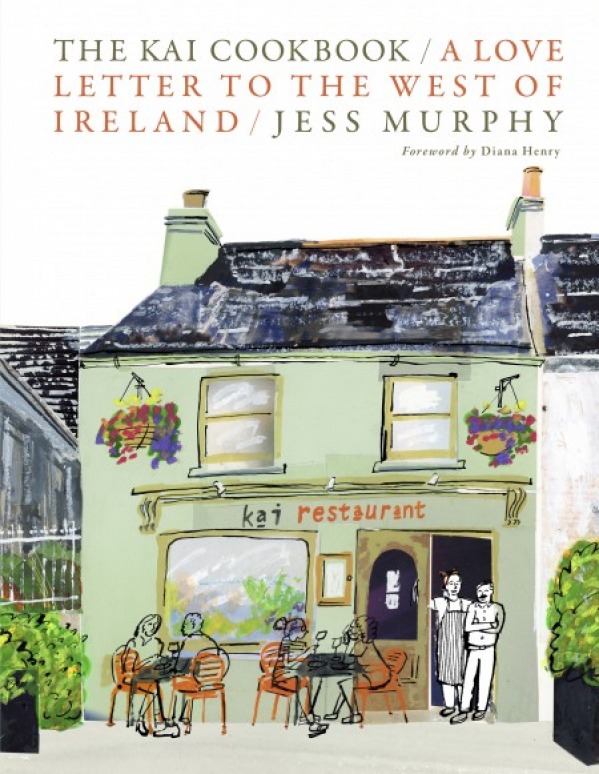
The Kai Cookbook
by Jess Murphy
(Nine Bean Rows, £30)
Photography: Nathalie Marquez Courtney
Join Our World... Sign up for our exclusive newsletter.

Be inspired every day with Living North



Injera is a sour, fermented flatbread made with teff, which is a fascinating grain. It’s been cultivated in Ethiopia for at least 3,000 years, and as a grain it can sustain an entire continent of people. Be careful with the batter, though, it can get explosive! One time I made it and the plastic lid on the bottle burst off with such force that it nearly took the head off Dave – it shot straight through my kitchen into the lounge. I still find bits of batter in there and on my kitchen tiles.
This stew is next level when eaten with injera. My pal Karen O’Donoghue from the Happy Tummy Co. in Westport, Mayo, makes and sells bottles of the batter that you can cook at home. She also makes amazing breads and other bits and bobs to help anyone with gut health issues – she’s been a lifesaver to me and many other people.
To make the injera, put the flour in a large plastic or clay bowl (not metal, it reacts with the batter). Mix in the water and leave to ferment for 24 hours at room temperature, at which point the batter will be foamy (this might take longer in the colder winter months). Whisk in the baking powder and salt, then set aside while you start the stew.
To make the stew, heat the olive oil in a large heavy-based saucepan or casserole on a medium heat. Add the onions and cook for about 10 minutes, until softened and translucent. Add the garlic and cook for one minute, just until fragrant, then add your spices and cook for one minute more.
Add the peppers, cavolo nero, squash and vegetable stock, pop on a lid and reduce the heat to low. Cook for about 25 minutes, until the squash is cooked through. Season to taste with salt and pepper.
Meanwhile, to cook the injera, wipe a crêpe pan with a damp cloth to create some much needed moisture, then add a little vegetable oil and put the pan on a medium-high heat. Pour a ladleful of batter in the middle of the pan, then spread it out in a clockwise swirl in a thin, even layer. Cook until bubbles appear on the surface, like a crumpet. Once it’s about 70 percent cooked, cover the pan with a large lid. Don’t ever flip injera – let it steam until the edges curl up. This takes practice, but it’s worth it.
Brush a piece of parchment paper with oil. When the injera is cooked, transfer it to the oiled paper and cook the next one. Repeat with the remaining batter, layering the injera between oiled pieces of parchment.
Serve the stew with the injera on the side.

Every autumn, Ernie makes a handwritten sign for every Irish apple variety with a quirky way to describe them. It’s little things like this that make my day as I walk to work. For 14 years, I’ve walked past Ernie’s shop, yelling ‘good morning’ to him. Ernie knows I’ll be working late into the night, so he’ll yell back, ‘Good morning, good evening and goodnight!’ Before he opened his shop, Ernie used to be a chef, and a good one at that, so he understands the day-to-day grind.
Preheat your oven to 180C. Grease and line 2 x 25cm cake tins with non-stick baking paper.
Put the butter in a saucepan on a medium heat and cook until it starts to foam. Now take it slightly further, until the noisy, bubbling butter gets quiet, turns a light brown colour and has a nutty aroma. Take the pan off the heat and allow to cool, then pour the browned butter into the bowl of a stand mixer fitted with the paddle attachment. Add both sugars and beat until well combined, then beat in the vanilla. Add the eggs one at a time, mixing well and scraping down the sides of the bowl between each one.
Combine the flour, baking powder and salt in a separate bowl, then add it to the butter and sugar mixture. Finally, beat in the milk, then fold in the apples. Divide the batter between the tins, then bake in the preheated oven for 35 minutes, until a skewer inserted into the middle of each cake comes out clean. Set aside to cool completely on wire racks.
Meanwhile, to make the caramel, put the sugar and water in a saucepan on a medium heat. Don’t mix them together or your sugar will crystallise. Just leave it alone and let the sugar melt until it turns a dark amber colour. Take the pan off the heat, add the butter and cream and mix vigorously. Put the pan back on the heat for two minutes, then remove the pan from the heat again, stir in the whiskey and set aside to cool fully.
To make the Swiss meringue buttercream, brown 100g of butter the same way you did before, then set aside to cool. Put your egg whites and sugar in a large metal bowl set over a pan of gently simmering water, making sure the water doesn’t touch the bottom of the bowl. When it reaches 71C on a digital thermometer, transfer the mixture to the bowl of a stand mixer fitted with the whisk attachment and whisk for eight to 10 minutes, until the bowl is cool, the meringue is shiny and smooth, and stiff peaks have formed.
Switch to the paddle attachment and beat in your plain butter a couple of cubes at a time. The mixture may appear split or curdled, but just keep mixing and it will become a smooth, shiny buttercream. Finally, beat in the browned butter.
To assemble, cut each cake in half horizontally. Put one layer on the base of a cake stand or serving platter and cover with a generous layer of the icing. Repeat with the remaining cakes and icing, making sure you save enough for the top too. Pour over the caramel, letting it drip down the sides of the cake. Serve with ice cream or custard.

If anyone ever described me or my star sign as being like osso buco, I would get a bit of a swoon on. My mates Enrico Fantasia (yes, that is his real name) and Andrew are my osso bucos. I’m a lot younger than them, so I’d probably be more like a slightly under seasoned but well-made polenta. Just being near them makes me happy. The day Kai got a bad review (that one cut deep), I spent all of brunch crying against the hand wash sink and recycled towel unit until I looked up and saw Enrico and Andrew come in and sit at table 13, two big lumps of men with the softest hearts who guided me through brunch like two tugboats making the water safe for me to sail in again. I aspire to be someone’s osso buco someday.
To make the osso buco, dust your lamb in flour on both sides.
Melt the butter in a large heavy-based casserole on a medium-high heat. Working in batches, add the meat and gently brown it on both sides. You’re not looking for intense browning here, just gently fry to get some colour on the lamb before braising. Transfer the browned lamb to a large plate. Repeat until all your lamb is nicely browned on both sides, then set aside.
Preheat your oven to 160C.
A nice fond should have developed on the bottom of the casserole, so it’s time to add your oil, onion, carrot, celery and a good pinch of salt to start pulling all the water from those veggies. Reduce the heat to medium and cook for about 15 minutes, scraping the bottom of the casserole every few minutes to get all that flavour.
Add your anchovies and tomato purée and cook for a few minutes to break down the anchovies and caramelise the tomato purée. Add the whole plum tomatoes, olives, chicken stock and bay leaves and bring it all together on a low heat. Add the lamb back to the casserole and taste for seasoning.
Pop the lid on the casserole, transfer it to the preheated oven and cook for about four hours, until the meat is extremely tender. However, you don’t want to overcook the meat and turn it mushy, so stop cooking when the meat is fork tender but still retains some texture. When the lamb has finished cooking, use a fork to pop the bone marrow from the cross-section of the lamb (the circle in the middle of the cut) into the sauce.
While the lamb is cooking, make the salsa verde. Put the garlic, chillies, toasted cumin seeds and a good pinch of salt in a blender and begin pulsing. Add all your herbs and keep pulsing while slowly pouring in your extra-virgin olive oil. Add your lime juice and season to taste with salt and pepper.
To serve, divide the osso buco among wide, shallow bowls and spoon the salsa verde on top.

(Nine Bean Rows, £30)
Photography: Nathalie Marquez Courtney